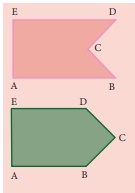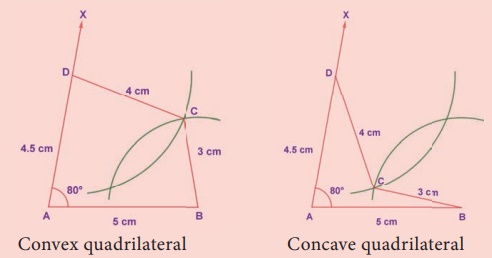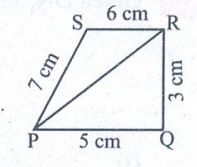Questions with Answers, Solution | Geometry | Chapter 5 | 8th Maths - Construction of Quadrilaterals | 8th Maths : Chapter 5 : Geometry
Chapter: 8th Maths : Chapter 5 : Geometry
Construction of Quadrilaterals
Construction
of Quadrilaterals
We have already
learnt how to draw triangles in the earlier classes. A polygon that has got 3 sides
is a triangle. To draw a triangle, we need 3 independent measures. Also, there is
only one way to construct a triangle, given its 3 sides. For example, to construct
a triangle with sides 3cm, 5cm and 7cm, there is only one way to do it.

Now, let
us move on to quadrilaterals. A polygon that is formed by 4 sides is called a quadrilateral.
Isn’t it? But, a quadrilateral can be of different shapes. They need not look like
the same for the given 4 measures. For example, some of the quadrilaterals having
their sides as 4 cm, 5 cm, 7 cm and 9 cm are given below

So, to construct
a particular quadrilateral, we need a 5th measure. That can be its diagonal
or an angle measure. Moreover, even if 2 or 3 sides are given, using the measures
of the diagonals and angles, we can construct quadrilaterals.
Note
We can split any quadrilateral into two triangles by drawing a diagonal.

In the above figures, a quadrilateral is split in two ways by its
diagonals. So, if a diagonal is given, first draw the lower triangle with two sides
and one diagonal. Then, draw the upper triangle with other two measures.
(i) • A polygon in which atleast one interior angle is more than
180°, is called a concave polygon. In the given polygon, interior angle at C is
more than 180°.

• A polygon in which each interior angle is less than 180°, is called
a convex polygon. In the given polygon, all interior angles are less than 180°.
(ii) Look at the following quadrilaterals.

Though, we can construct a quadrilateral in two ways as shown above,
we do not take into account the concave quadrilaterals in this chapter. Hence, the
construction of only convex quadrilaterals are treated here.
Note
Consider the given Quadrilateral ABCD. In which AC is a diagonal
(d), BE (h1) and DF (h2)
are the perpendiculars drawn from the vertices B and D on diagonal AC.
Area of quadrilateral ABCD = Area of ∆ABC + Area of ∆ACD

We shall
now see a few types on constructing these quadrilaterals when its:
(i) 4 sides
and a diagonal are given.
(ii) 3
sides and 2 diagonals are given.
(iii) 4 sides
and an angle are given.
(iv) 3
sides and 2 angles are given.
(v) 2 sides
and 3 angles are given.
1. Constructing
a quadrilateral when its 4 sides and a diagonal are given
Example 5.21
Construct
a quadrilateral DEAR with DE=6 cm,
EA = 5 cm, AR = 5.5cm, RD
= 5.2 cm and DA = 10 cm. Also find its
area.
Solution:
Given:
DE = 6 cm, EA = 5 cm,
AR = 5.5 cm,
RD = 5.2 cm and a diagonal
DA = 10 cm

Steps:
4. Draw a
line segment DE = 6 cm.
5. With D and E as centres, draw arcs of radii 10 cm and 5 cm respectively and
let them cut at A.
6. Join DA and EA.
7. With D and A as centres, draw arcs of radii 5.2 cm and 5.5 cm respectively
and let them cut at R.
8. Join DR and AR .
9. DEAR is the required quadrilateral.

2. Construct
a quadrilateral when its 3 sides and 2 diagonals are given
Example 5.22
Construct
a quadrilateral NICE with NI=4.5 cm, IC= 4.3 cm, NE=
3.5 cm, NC= 5.5 cm and IE = 5 cm. Also find its area.
Solution:
Given:
NI = 4.5 cm, IC= 4.3 cm,
NE = 3.5 cm and two diagonals,
NC = 5.5 cm and IE = 5 cm

Steps:
1. Draw a
line segment NI = 4.5 cm.
2. With N and I as centres, draw arcs of radii 5.5 cm and 4.3 cm respectively
and let them cut at C.
3. Join NC and IC.
4. With N and I as centres, draw arcs of radii 3.5 cm and 5 cm respectively and
let them cut at E.
5. Join NE, IE
and CE .
6. NICE is the required quadrilateral.

3. Construct
a quadrilateral when its 4 sides and one angle are given
Example 5.23
Construct
a quadrilateral MATH with MA=4 cm,
AT= 3.6 cm, TH = 4.5 cm, MH=
5 cm and ∠A = 85º . Also find its area.
Solution:
Given:
MA=4 cm, AT= 3.6 cm,
TH = 4.5 cm, MH= 5 cm and ∠A = 85º

Steps:
1. Draw a
line segment MA = 4 cm.
2. Make ∠A = 85º .
3. With A as centre, draw an arc of radius 3.6 cm. Let it cut the ray AX at T.
4. With M and T as centres, draw arcs of radii 5 cm and 4.5 cm respectively
and let them cut at H.
5. Join MH and TH.
6. MATH is the required quadrilateral.
Calculation of Area:
Area of the
quadrilateral MATH = 1/2 ×
d × ( h1 + h2
) sq. units
= 1/2 ×
5.1×
(3.9 +
2.8)
= 2.55 ×
6.7 = 17.09 cm2

4. Construct
a quadrilateral when its 3 sides and 2 angles are given
Example 5.24
Construct
a quadrilateral ABCD with AB=7 cm,
AD= 5 cm, CD = 5 cm, ∠BAC = 50º and ∠ABC = 60º. Also find its area.
Solution:
Given:
AB=7 cm, AD= 5 cm, CD = 5 cm and two angles ∠BAC = 50º and ∠ABC = 60º

Steps:
1. Draw a
line segment AB = 7 cm.
2. At A on AB
, make ∠BAY = 50º and at B on AB,
make ∠ABX = 60º . Let them intersect
at C.
3. With A and C as centres, draw arcs of radius 5 cm each. Let them intersect at D.
4. Join AD
and CD.
5. ABCD is the required quadrilateral.
Calculation of Area:
Area of the quadrilateral
ABCD = 1/2 × d × ( h1 + h2 ) sq. units
= 1/2 × 6.4 × (3.8 +
5.3)
= 3.2 × 9.1 = 29.12
cm2

5. Construct
a quadrilateral when its 2 sides and 3 angles are given
Example 5.25
Construct
a quadrilateral PQRS with PQ=QR=5 cm, ∠QPR = 50°, ∠PRS = 40° and ∠RPS = 80°. Also find its area.
Solution:
Given:
PQ= 5
cm, QR=5 cm, ∠QPR
= 50°,
∠PRS = 40° and ∠RPS = 80°

Steps:
1. Draw a
line segment PQ = 5 cm.
2. At P on PQ,
make ∠QPX = 50°.
3. With Q as centre, draw an arc of radius 5 cm. Let it cut PX at R.
4. At R on PR,
make ∠PRS = 40° and at P on PR, make ∠RPS = 80°. Let them
intersect at S.
5. PQRS is the required quadrilateral.
Calculation of Area:
Area of
the quadrilateral PQRS = 1/2 × d × ( h1 + h2 ) sq. units
= 1/2
× 6.4 × (4.7 + 3.8)
= 3.2
× 8.5 = 27.2 cm2

Think
Is it
possible to construct a quadrilateral PQRS
with PQ = 5 cm, QR = 3 cm, RS
= 6 cm, PS = 7 cm and PR = 10 cm. If not, why?
Solution:

The lower triangle cannot be constructed as the sum of two sides
5 + 3 = 8 < 10 cm. So this quadrilateral cannot be constructed.
Related Topics